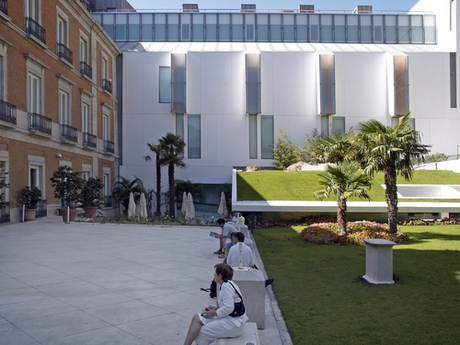The Thyssen-Bornemisza Museum
Occupying a Neo-Classical mansion from 1806, many critics see this museum as the world's most important private art collection. Assembled by Baron Heinrich Thyssen-Bornemisza and his son Hans Heinrich, it illustrates the history of Western art from the primitive Flemish and Italian painters, to 20th century Pop Art.
Standing almost opposite the Prado Museum and very near to the Reina Sofía Modern Art Museum, this new museum, which architect Rafael Moneo was commissioned to design, was the missing cornerstone that finally sealed the triangle of art. With the presence of the Thyssen-Bornemisza Collection, the most important private collection in the world before it was acquired by the Spanish state in June 1993 for 350 million dollars, few cities can match Madrid’s appeal for art lovers.
One of the key characteristics of the Thyssen-Bonemisza Museum is that it complements the Prado’s collection of old paintings and the modern art housed at the Reina Sofía Museum, featuring movements and styles such as the Italian and Dutch primitives, German Renaissance art, 17th century Dutch painting, Impressionism, German Expressionism, Russian Constructivism, Geometric Abstraction and Pop Art. And, setting it apart, its singular display of 19th century North American painting, practically unknown in Europe, which occupies two halls of the museum.
The history and origins of the Thyssen-Bornemisza collection tell one of the most fascinating tales of private collecting. Although the collection boasted worldwide renown, when the Thyssen-Bornemisza Museum opened in Madrid in October 1992, showcasing the core of the collection together for the very first time, one thing that prompted most admiration was that such a large number of works, and such quality works, had been collected in just two generations. It was, without a doubt, the most important private art collection of the 20th century.
Created in 1988, the Thyssen-Bornemisza Collection Foundation pioneered a new formula for the private management of public assets in Spain, and its efficacy has been apparent ever since the museum opened its doors in October 1992. Since that time, both the museum and the foundation that manages it have grown and evolved, expanding the collections and facilities with the addition of the Carmen Thyssen-Bornemisza Collection as a long-term loan in 2004 and the extension of the Villahermosa Palace, as well as increasing the number and variety of activities, temporary exhibitions and educational programs. The team of people who makes the institution’s daily existence possible has also been augmented, but the motor that keeps the foundation running smoothly has always been their drive and motivation.
Throughout its history, the museum has always placed particular emphasis on its goal of disseminating the collection with programs and activities designed to involve every kind of audience in its cultural project. This is still a top priority, as is the goal of satisfying the demands of visitors and collaborators by applying criteria of constant innovation and quality. The museum’s strategy is to achieve a streamlined administrative management, seeking to maximize revenues and control the costs involved in organizing an intense program of cultural activities, as well as to ensure optimum gallery conditions, maintenance of the facilities and high standards for services. Our commitment is to raise the bar of quality in the Spanish cultural arena by implementing transparent, effective and efficient management practices.
The Spanish state bought it in 1993, and today this museum is a strong complement to the Prado and Reina Sofia museums, adding 20th century international artists to the Spanish ones you may have already seen at Reina Sofia. With this museum, you can truly appreciate the entire evolution of the history of art without leaving Madrid.
The Thyssen's medieval works are especially outstanding, with a highlight being Van Eyck's "Diptych of the Annunciation". Petrus Christus' "Our Lady of the Dry Tree" and Holbein's celebrated portrait of Henry VIII are two other examples to look out for, as are Rubens' "The Toilet of Venus" and Rembrandt's Self-Portrait, both dating from the 17th century.
Later works include a collection of Impressionist and post-Impressionist examples, notably Degas' "Swaying Dancer," a couple of Van Gogh paintings, and Cézanne's "Portrait of a Farmer."
From the 20th century, see Picasso's "Man with a Clarinet" and "Harlequin with a Mirror," this last one thought by some to represent the artist himself. Other big names from that century in the surrounding galleries include Miró, Dali, Bacon, and Pollock, whose "Brown and Silver I" is especially worth paying close attention to. The same goes for Edward Hopper's "Hotel Room," seen as a study of urban isolation.
With such a wealth of art, it is not surprising that this magnificent museum attracts almost one million visitors every year. It further makes Madrid the envy of the art world, since the city outbid everyone else for the collection (including the Getty Foundation) and it was a great deal for the Spanish capital, since although valued at an estimated $1 billion, the collection was bought for $350 million.
After a visit, head to the café-restaurant for its magnificent views of the garden.
Opening hours of the Thyssen-Bornemisza Museum:
- Tuesdays to Sundays and on Public Holidays: 10am to 7pm
- 24th December & 31st December: 10am to 3pm
- Museum closed on Mondays, 25th December, 1st January and 1st May.
Entrance fees:
- Free entry for children under 12.
- Reduced prices are available for senior citizens and students. Please check all conditions at the ticket office
- General entrance fee: 6 euros, purchased at the ticket office from 10am to 6:30pm
You can get there via flight to Madrid.




